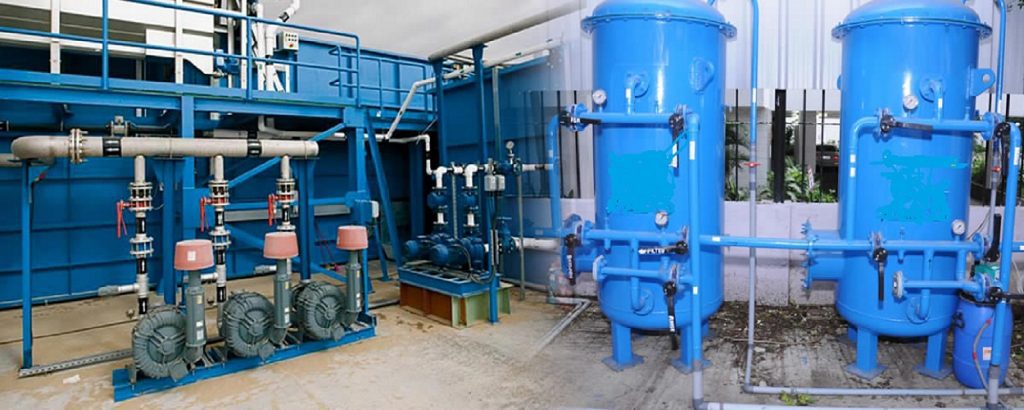Water treatment plants (WTP) are crucial for ensuring the delivery of safe and clean water, especially in Bangladesh, where water contamination poses significant health risks. At MBELBD, a leader in water treatment solutions, we specialize in designing and installing WTPs tailored to the specific needs of our clients. In this article, we explore the chemicals used in water treatment, the processes involved, how to calculate WTP capacity, chemical dosing, and essential parameters to monitor.

- Chemicals Used in Water Treatment Plants (WTP)
At MBELBD, we understand the importance of using the right chemicals to treat water effectively. Chemicals used in WTPs help in removing impurities, neutralizing pathogens, and ensuring water is safe for consumption. Here are some of the most commonly used chemicals in water treatment:
Chlorine: A powerful disinfectant that eliminates bacteria, viruses, and other microorganisms.
Alum (Aluminum Sulfate): Functions as a coagulant to bind small particles, allowing them to settle for easier filtration.
Sodium Hypochlorite: Used as an alternative to chlorine gas for disinfection.
Ferric Chloride: Another coagulant, particularly effective in removing organic compounds and improving water clarity.
Lime (Calcium Hydroxide): Added to adjust the pH of water to an optimal range.
Activated Carbon: Removes organic contaminants, chlorine, and odors.
Antiscalants: Prevent scale formation in equipment, crucial in advanced treatment processes like reverse osmosis.
These chemicals, used in the correct doses, ensure that water meets safety and quality standards before being distributed to the public.
- The Water Treatment Process at MBELBD
Our water treatment plants at MBELBD follow a systematic process to deliver clean, safe drinking water. The process involves several steps:
Screening: The first step, where large debris, such as leaves, plastic, and other solid waste, is filtered out from the raw water source.
Coagulation and Flocculation: Coagulants like alum or ferric chloride are added to the water. These chemicals bind small particles into larger clumps (flocs), making them easier to remove.
Sedimentation: The water is left in sedimentation tanks, allowing the heavy floc to settle at the bottom.
Filtration: The water passes through filters made of sand, gravel, and carbon, which remove suspended particles and any remaining impurities.
Disinfection: Chlorine or sodium hypochlorite is added to kill harmful microorganisms. This ensures that the water remains safe as it travels through distribution pipes.
pH Adjustment: Chemicals like lime or sodium hydroxide may be added to adjust the water’s pH to a neutral or slightly alkaline level, which helps prevent corrosion in pipes and makes the water safer for consumption.
At MBELBD, we focus on designing treatment systems that follow these steps to ensure optimal water quality for communities across Bangladesh.
- How to Calculate WTP Capacity
WTP capacity calculation is vital to ensure that the plant can treat the required amount of water. At MBELBD, we calculate WTP capacity based on the expected daily water demand and the plant’s operational efficiency. The formula for calculating WTP capacity is:
WTP Capacity (m³/day)
Daily Water Demand (m³/day)
Operating Efficiency (%)
WTP Capacity (m³/day)=
Operating Efficiency (%)
Daily Water Demand (m³/day)
For example, if a WTP is expected to treat 20,000 m³ of water per day and has an operational efficiency of 95%, the WTP capacity would be:
- What is WTP Chemical Dosing?
At MBELBD, we emphasize the importance of precise chemical dosing. Chemical dosing refers to the controlled addition of chemicals during various stages of water treatment. Dosing the right amount of chemicals ensures that the treatment process is effective and efficient without overdosing, which can lead to water quality issues.
For example, chlorine is dosed to disinfect water. The dosing rate depends on the chlorine demand of the water, usually measured in milligrams per liter (mg/L). If the chlorine demand is 4 mg/L and the WTP treats 15,000 m³ of water daily, the chlorine dose is calculated as:
60 kg/day
Chlorine Dose=15,000×4×10
−3
=60kg/day
This calculation helps ensure that the right amount of chlorine is added to the water to maintain safety and quality without causing harmful side effects like chlorine odor or taste.
- Key Parameters to Monitor in a WTP
At MBELBD, we monitor various parameters to ensure that the WTP operates efficiently and produces water that meets quality standards. Some of the key parameters include:
pH Level: The pH of treated water is typically maintained between 6.5 and 8.5 to ensure it is neither too acidic nor too alkaline.
Turbidity: A measure of water clarity, turbidity levels should be kept low to ensure that the water is free from suspended particles.
Residual Chlorine: After disinfection, there must be some residual chlorine in the water to prevent microbial growth during distribution. Residual chlorine is typically maintained between 0.2 and 0.5 mg/L.
Total Dissolved Solids (TDS): TDS measures the concentration of dissolved substances in water. Drinking water should have a TDS level below 500 mg/L, according to World Health Organization (WHO) guidelines.
Bacteriological Quality: Regular testing for harmful bacteria like E. coli is essential to ensure that the water is safe for human consumption.
By monitoring these parameters, MBELBD ensures that the water treatment process is effective and the water produced is safe for public use.
Water treatment is essential for providing clean and safe water in Bangladesh, and at MBELBD, we are committed to delivering high-quality water treatment solutions. By understanding the chemicals used, following a structured water treatment process, accurately calculating capacity, and ensuring proper chemical dosing, we ensure that our water treatment plants operate at peak efficiency. We also continuously monitor key water parameters to ensure that the treated water meets all safety and quality standards.
Our mission at MBELBD is to provide sustainable, efficient, and safe water treatment solutions to meet the growing needs of Bangladesh’s population. Whether you’re looking to install a new WTP or upgrade an existing one, MBELBD has the expertise and solutions you need for clean water and a healthier future.
